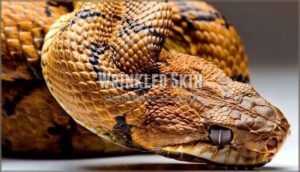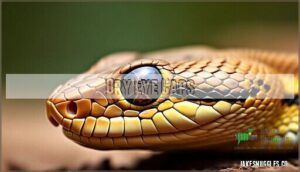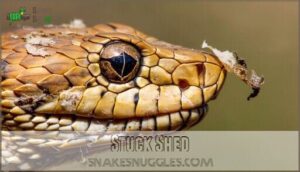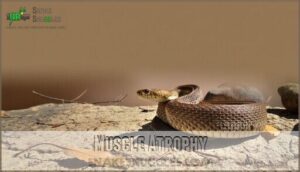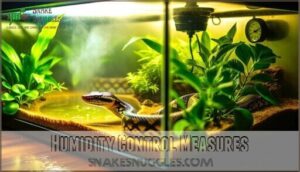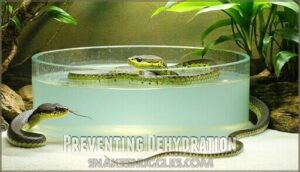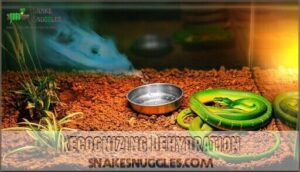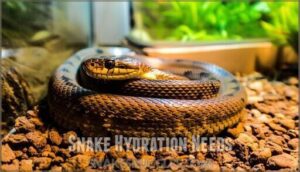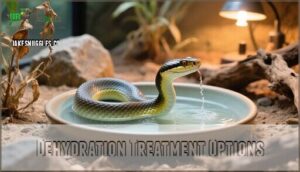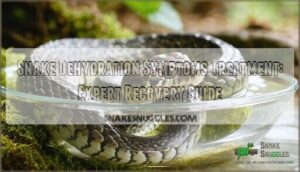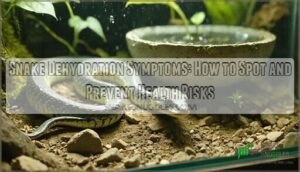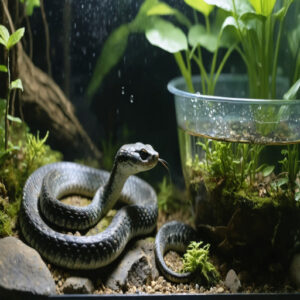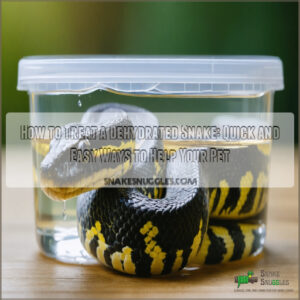This site is supported by our readers. We may earn a commission, at no cost to you, if you purchase through links.
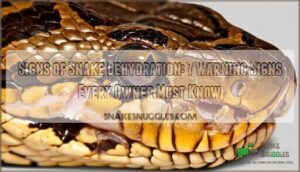 You’ll spot snake dehydration through several telltale signs that develop gradually but can escalate quickly.
You’ll spot snake dehydration through several telltale signs that develop gradually but can escalate quickly.
Watch for wrinkled, loose skin that doesn’t bounce back when gently pinched—healthy snake skin should feel firm and elastic.
Sunken eyes and dry, cracked eye caps signal serious fluid loss, while lethargy and reduced appetite often accompany dehydration.
Stuck shed with retained skin patches is another red flag, as is a dry, pale mouth with a stiff tongue.
Flaky, patchy skin resembling chapped lips indicates poor hydration levels.
These warning signs aren’t just cosmetic issues—they’re your snake’s way of telling you something’s seriously wrong with their water balance and environment, and that dehydration can have severe consequences.
Table Of Contents
- Key Takeaways
- Snake Dehydration Causes
- Signs of Dehydration
- Dehydration Symptoms
- Treating Dehydrated Snakes
- Humidity Control Measures
- Preventing Dehydration
- Recognizing Dehydration
- Snake Hydration Needs
- Dehydration Treatment Options
- Maintaining Proper Hydration
- Frequently Asked Questions (FAQs)
- How to tell if a snake is dehydrated?
- What are the 5 warning signs of dehydration?
- How do I rehydrate my snake?
- How do I know if my snake is drinking water?
- How do I know if my snake is dehydrated?
- What are three warning signs of dehydration?
- How to tell if a snake is drinking water?
- How long can snakes survive without water?
- Do baby snakes dehydrate faster than adults?
- Can snakes drink from water bottles or tubes?
- Conclusion
Key Takeaways
- Check skin elasticity – Gently pinch your snake’s skin and watch how quickly it snaps back; dehydrated skin stays tented for several seconds instead of immediately returning to normal.
- Monitor eyes and mouth – Look for sunken, dull eyes with cracked eye caps, plus a dry, pale mouth with sticky membranes and a stiff tongue.
- Watch for shedding problems – You’ll notice stuck shed patches, retained spectacles around the eyes, and incomplete skin removal that comes off in pieces rather than one complete shed.
- Observe behavior changes – Your snake will become lethargic, hide more often, refuse food, and show dramatically reduced activity levels during normal periods.
Snake Dehydration Causes
Understanding what causes snake dehydration helps you prevent this serious health issue before it starts.
Your snake’s hydration depends on proper water access, correct humidity levels, overall health, and environmental conditions that match their natural habitat needs.
Lack of Water Access
Without access to clean water, your snake faces serious health risks.
Clean water isn’t optional—it’s your snake’s lifeline to survival
Water dish size matters – it should allow full-body soaking for proper hydration. Water dish placement affects usage; shy snake hydration improves when dishes are positioned near hiding spots.
Multiple snakes need separate water sources to prevent competition.
Water source cleanliness is essential since dirty dishes discourage drinking, leading to snake dehydration and reduced snake water intake, which affects overall health.
Incorrect Humidity Levels
Wrong humidity levels frequently trigger snake dehydration causes.
Your snake’s habitat humidity requirements vary by species – corn snakes need 40-50% while ball pythons require 60-70%.
Monitor with digital hygrometers since guesswork fails.
Seasonal changes, enclosure size, and substrate choice all affect moisture levels.
Screen tops drain humidity fast, so you’ll need humidity monitoring systems or covers to maintain proper levels consistently.
Inadequate humidity can lead to incomplete shedding problems, which is a significant issue in reptile care.
Underlying Illnesses
Several underlying health issues can trigger dehydration in your snake, creating a dangerous cycle.
Parasite infections like mites cause blood loss and weakness, while respiratory issues increase water loss through open-mouth breathing.
Kidney failure impairs water regulation, making dehydration worse.
Stress factors from illness suppress appetite and drinking.
These underlying health issues often cause shedding problems too.
Snakes with dehydration may also show signs of respiratory distress.
Environmental Factors
Environmental factors play a vital role in snake dehydration, turning your pet’s home into either a moisture oasis or an arid wasteland.
Your snake’s environment can make or break their hydration—creating either the perfect moisture haven or a deadly desert
Poor habitat mimicry creates the perfect storm for dehydration problems.
- Temperature gradients that are too hot dry out the air and your snake
- Water availability becomes limited when bowls are too small or poorly placed
- Enclosure ventilation that’s excessive removes essential humidity levels
- Shedding environment lacks proper humidity during critical molting periods
Signs of Dehydration
When your snake starts looking like a raisin, it’s time to pay attention. Recognizing dehydration early can save your pet’s life and prevent serious health complications.
Don’t wait until your snake looks like leather—spot dehydration before it becomes dangerous.
Wrinkled Skin
Your snake’s skin becomes wrinkled and loose when dehydrated, losing its normal elasticity.
Check for skin folds around the neck and body bends where wrinkles appear most prominently.
In severe cases, the scale appearance changes dramatically, creating accordion-like ridges.
When you gently pinch the skin, it stays tented instead of snapping back immediately.
These identifying wrinkles are key snake dehydration signs you can’t ignore, which are often indicated by clear visual changes.
Dry Eye Caps
Cracked eye caps signal serious snake dehydration symptoms that demand immediate attention.
These transparent shields protecting your snake’s eyes become dented, fractured, or completely dried out when fluid levels drop dangerously low.
Eye cap problems often accompany retained spectacles during shedding cycles.
Without proper treatment options like humidity chambers and soaking, preventing damage becomes nearly impossible as dry snake skin worsens rapidly.
Sunken Eyes
Beyond dry eye caps, healthy eyes can quickly lose their normal appearance when your snake faces dehydration.
Sunken eyes snake dehydration signs include eyes that appear recessed or hollow, creating a distinctly unwell look.
These snake dehydration symptoms develop as fluid loss causes the eyeballs to sink deeper into their sockets.
Prevention involves maintaining proper humidity levels and fresh water access always, which is crucial for preventing dehydration.
Lethargy
One minute your snake’s exploring every corner of their enclosure, the next they’re barely moving.
This dramatic shift signals potential dehydration trouble brewing.
Lethargic snake behavior includes reduced movement, staying hidden longer, and appearing sluggish during handling.
Snake dehydration signs like lethargy often accompany other symptoms, creating a cascade of health issues.
Snake behavior changes become noticeable as your pet loses energy reserves through fluid loss, leading to a state of overall lethargy.
Reduced Appetite
When your snake starts refusing food, it’s often signaling dehydration alongside that sluggish behavior.
Decreased appetite is a common snake dehydration sign that shouldn’t be ignored. Dehydrated snakes lose interest in their dietary needs because their bodies prioritize conserving energy.
This snake behavior of refusing food can lead to nutritional deficiencies if left untreated. Never attempt force feeding, as this creates additional stress. Instead, address the underlying snake dehydration first.
Dehydration Symptoms
Beyond the initial warning signs, dehydration symptoms become more severe and harder to miss. These advanced indicators require immediate attention to prevent serious health complications.
Stuck Shed
Proper shedding requires adequate moisture, and dehydration creates a domino effect of snake shedding problems.
When your snake can’t shed completely, you’ll notice patches of old skin clinging stubbornly to their body. This condition, called dysecdysis, signals serious hydration issues.
Watch for these stuck shed warning signs:
- Retained spectacles – old eye caps that won’t come off
- Tail tip patches – dried skin wrapped around the tail end
- Body segments – accordion-like skin folds that remain attached
- Nose pieces – flaky skin around nostrils and mouth
- Incomplete removal – shed comes off in pieces rather than one piece
Dry Mouth
When inspecting your snake’s mouth, healthy mucous membranes should appear moist and pink.
In snake dehydration, the mouth becomes pale and sticky, with dry mouth membranes that feel tacky to touch.
During mouth examination, you’ll notice the tongue appearance changes dramatically – it becomes dry and less flexible.
This oral hydration loss requires immediate veterinary assessment to prevent serious complications.
| Normal Mouth | Dehydrated Mouth |
|---|---|
| Moist, pink membranes | Pale, sticky membranes |
| Flexible, wet tongue | Dry, stiff tongue |
| Smooth oral tissues | Tacky, dry tissues |
Flaky Skin
Your snake’s flaky skin resembles chapped lips and signals poor skin hydration. This dull, dry appearance indicates your pet’s scale health is compromised by snake dehydration.
Unlike normal shedding process patterns, flaky skin appears patchy and irregular. Environmental impact from low humidity creates these nutritional deficiencies-like symptoms.
Check for snake skin wrinkling alongside the flakiness—both suggest immediate attention needed for proper skin condition restoration.
Muscle Atrophy
Beyond flaky skin, muscle atrophy represents serious snake dehydration signs requiring immediate veterinary intervention.
Dehydrated snakes lose muscle mass as protein deficiency develops, creating visible muscular atrophy along their bodies. This condition affects snake body condition dramatically.
Key atrophy causes include:
- Chronic water deprivation leading to protein breakdown
- Illness-related appetite loss reducing muscle maintenance
- Poor hydration impact on cellular function
Fortunately, atrophy reversibility occurs with proper rehydration therapy.
Treating Dehydrated Snakes
Once you’ve identified dehydration signs in your snake, quick action can prevent serious health complications.
The good news is that most cases respond well to simple home treatments when caught early.
Providing Fresh Water
After recognizing snake dehydration signs, you’ll need fresh water immediately.
Keep your snake water dish filled with clean water daily.
Water dish size matters – it should accommodate your snake’s body length.
Use bottled spring water instead of tap water for consistency.
For shy snake solutions, place multiple water bowls in hidden locations throughout the enclosure.
Soaking in Warm Water
Gentle warm water soaks provide immediate relief for dehydrated snakes. You’ll want to create a therapeutic bath that helps your snake rehydrate safely and effectively.
Here’s your step-by-step soaking process:
- Water Temperature: Maintain 80-85°F using a thermometer for accurate temperature control
- Soaking Duration: Limit sessions to 10-20 minutes to prevent stress or overexposure
- Water Quality: Use dechlorinated or bottled water, ensuring it’s shallow enough for easy breathing
- Snake Handling: Support your snake gently, allowing natural movement while supervising constantly
- Post-Soak Care: Dry thoroughly before returning to the enclosure to prevent skin issues
This snake dehydration treatment works by allowing water absorption through the skin. Monitor your snake’s comfort level throughout these rehydration techniques.
Electrolyte Soaks
Commercial electrolyte soaks offer more than basic hydration for your snake.
These solutions contain sodium, potassium, and vitamins that support cellular function during dehydration recovery.
Mix commercial products at recommended concentrations—typically 75% electrolyte solution with 25% water.
Soak your snake for 10-20 minutes in warm water, and monitor for stress signals throughout treatment sessions to ensure the snake’s well-being and safety, providing proper care.
Humidity Chambers
Humidity chambers create a concentrated moisture environment that accelerates your snake’s rehydration process.
These specialized enclosures maintain higher humidity levels than standard setups, providing targeted hydration therapy for dehydrated reptiles.
You can find a suitable chamber online for your snake.
Essential humidity chamber components:
- Chamber Materials – Clear plastic containers with secure, ventilated lids
- DIY Chambers – Repurposed food containers with dampened sphagnum moss substrate
- Chamber Size – Spacious enough for your snake to stretch comfortably inside
- Chamber Maintenance – Daily moisture checks and weekly substrate replacement schedules
- Species Needs – Tropical species require 80-90% humidity versus desert species’ 60-70%
Humidity Control Measures
Once you’ve identified dehydration signs in your snake, controlling humidity becomes your most important tool for recovery.
Proper humidity management through humid hides, temperature regulation, hygrometers, and misting systems can prevent future dehydration episodes and support your snake’s overall health.
Humid Hides
Creating a humid hide prevents snake dehydration by maintaining essential moisture levels.
Choose hide materials like sphagnum moss or damp paper towels that retain water well.
Location matters – place it on the warm side where your snake spends time.
Size considerations guarantee your snake fits comfortably inside.
Cleaning frequency should be weekly to prevent mold.
Different species preferences require varying humidity levels for ideal snake hydration, and it is crucial to maintain the right conditions to prevent snake dehydration.
Temperature Settings
Proper temperature management goes hand in hand with humidity control for preventing snake dehydration. Your thermostat use guarantees consistent heat gradients that support natural moisture retention.
Night temperatures shouldn’t drop too drastically, as temperature swings affect your snake’s hydration needs.
- Position your basking spot at species-appropriate temperatures (85-95°F for most)
- Use infrared lamps to create gentle heat gradients without drying air
- Maintain stable night temperatures within 5-10°F of daytime lows to ensure consistent heat and support natural moisture retention.
Hygrometer Use
Why guess when you can measure? A hygrometer is your snake’s humidity guardian, preventing snake dehydration before it starts.
Digital models offer superior accuracy compared to analog versions. Place your hygrometer at snake level, not on cage tops where readings skew higher.
Calibrate monthly using salt tests to guarantee accuracy within 3-5%. Consider hygrometer product options for peak performance.
Monitor humidity trends daily, not just single readings, to catch environmental shifts that affect your snake’s health.
Auto-Misting Systems
Auto-misting systems offer snake keepers a "set-and-forget" solution for consistent humidity control.
These programmable units deliver timed sprays every few hours, maintaining stable moisture levels that prevent snake dehydration.
Quality systems feature adjustable nozzles and multi-gallon reservoirs, reducing daily maintenance.
For a variety of options, consider a complete misting setup.
Use distilled water to prevent clogs, and adjust misting schedules based on your snake’s species-specific needs for ideal results, ensuring a stable environment.
Preventing Dehydration
You can prevent dehydration by understanding your snake’s specific needs and maintaining proper care routines.
Research your species’ humidity requirements, provide fresh water daily, and monitor your snake’s condition regularly to catch early warning signs.
Researching Species Needs
Before jumping into snake ownership, you’ll need to master the specific requirements that keep your scaly friend healthy.
Different species need vastly different conditions – what works for one snake can literally kill another.
Key research areas include:
- Temperature gradients and basking spots for proper thermoregulation
- Humidity ranges that match your snake’s natural habitat requirements
- Feeding schedules and prey sizes appropriate for your species and snake’s age.
Understanding individual variation within species helps prevent snake dehydration causes.
Some ball pythons thrive at 55% humidity while others need 65%.
Veterinary consultation during setup confirms you’re meeting diet considerations and habitat mimicry needs perfectly.
Feeding High-Moisture Prey
You’ll boost snake hydration by choosing high-moisture prey over dry options.
Frozen-thawed prey retains more water than freeze-dried alternatives, supporting your snake’s fluid needs.
Amphibians, fish, and invertebrates offer superior prey moisture content compared to standard rodents.
Gut loading feeder insects with water-rich foods increases their hydration value.
Prey size guidelines are important for safe digestion.
This dietary approach complements proper husbandry for ideal snake health.
Avoiding Overfeeding
Overfeeding creates a dangerous cycle that worsens snake dehydration. The digestive process demands significant water reserves, and excess meals strain your snake’s system.
Large prey items require more fluids to break down, while frequent feeding overwhelms digestive health.
- Obesity Risks: Extra weight stresses organs and reduces water efficiency
- Regurgitation Signs: Undigested meals waste precious body fluids
- Prey Size: Oversized meals demand excessive digestive fluids
- Feeding Schedule: Too-frequent meals deplete hydration reserves
Monitoring Hydration
Regular physical assessments help you catch dehydration early.
Check your snake’s skin elasticity weekly by gently pinching it—healthy skin snaps back quickly.
Monitor behavior observation for lethargy or reduced activity.
Examine waste for thick, white urates indicating dehydration.
Track hydration frequency and environmental monitoring using hygrometers.
Document these snake hydration monitoring practices to prevent serious snake dehydration consequences requiring snake hydration veterinary care.
Recognizing Dehydration
You need to spot dehydration early before it becomes a serious health threat to your snake. Recognizing the warning signs helps you take quick action and keep your pet healthy.
Skin Elasticity
The pinch test reveals your snake’s hydration levels instantly.
Gently pinch a skin fold along your snake’s side and release it.
Healthy skin snaps back immediately, while dehydrated skin stays tented for several seconds.
This tenting duration indicates poor skin elasticity, a clear snake dehydration symptom.
Check scale appearance too—wrinkled or accordion-like folds signal trouble, and also look for poor skin elasticity.
Eye Cap Condition
Your snake’s eyes can tell you a lot about its hydration status.
When dehydrated, eyecaps become dented, cracked, or cloudy instead of clear and smooth. Sunken eyes create a hollow appearance that’s hard to miss.
Retained spectacles from incomplete sheds often indicate chronic dehydration issues.
- Eye cap cloudiness – Clear eyecaps turn milky or opaque when fluid levels drop
- Sunken eyes – Dehydration causes eyes to appear recessed and dull
- Retained spectacles – Old eyecaps stick during sheds, creating layered buildup
Shedding Difficulties
Incomplete shedding signals serious hydration problems in your snake.
When snake hydration drops, the old skin won’t come off properly, creating patchy remnants called retained spectacles around the eyes and nose.
This dysecdysis affects shed quality dramatically.
Different snake species have varying shedding environment needs, but all require adequate moisture for successful snake shedding.
Poor skin condition directly impacts shed frequency and overall health.
Activity Levels
Typically, a dehydrated snake’s energy levels drop noticeably.
You’ll see reduced movement during normal activity periods.
Your snake may skip its usual nighttime activity or avoid basking habits entirely.
Snake dehydration causes lethargy that affects behavior patterns.
Watch for decreased appetite alongside lower energy.
These changes signal your pet needs immediate hydration attention.
Snake Hydration Needs
Your snake’s hydration needs depend on its species, environment, and current health condition. Understanding these factors helps you provide proper care and catch dehydration before it becomes dangerous.
Species-Specific Requirements
Different snake species have vastly different hydration needs that you’ll need to match.
Tropical species like ball pythons require 60-80% humidity and larger water dish size, while desert species thrive at 30-40% humidity.
Arboreal hydration comes from misting, as tree-dwelling snakes collect droplets naturally.
Understanding your snake species care requirements prevents dehydration through proper humidity gradients and species-specific setups.
Environmental Influences
Your snake’s environment directly impacts hydration needs through five key factors:
- Habitat Mimicry – Desert species need lower humidity than rainforest natives
- Seasonal Changes – Winter heating reduces air moisture substantially
- Enclosure Size – Smaller spaces lose humidity faster than larger ones
- Substrate Choice – Cedar chips absorb moisture while cypress mulch retains it
- Geographic Origin – Ball pythons from humid Africa need different conditions than corn snakes from temperate regions
Temperature and water sources must match your snake’s natural environment to prevent snake dehydration effectively.
Maintaining proper hydration supports a snake’s thermal regulation needs.
Health Status
Your snake’s overall health status directly impacts hydration levels and dehydration risk.
Underlying conditions like respiratory infections or parasites create additional fluid loss, while stress factors and poor kidney function in older snakes compound the problem.
| Health Factor | Impact on Hydration |
|---|---|
| Kidney Function | Declining efficiency increases dehydration risk, especially in senior snakes |
| Respiratory Health | Infections cause fluid loss through increased breathing effort |
| Parasite Impact | Internal parasites trigger diarrhea and rapid fluid depletion |
| Stress Factors | Chronic stress weakens immune system and reduces water intake |
| Shedding Health | Compromised skin renewal requires extra moisture for proper completion |
Monitoring these snake health issues helps you catch signs of dehydration in snakes early.
Regular veterinary care guarantees proper snake dehydration prevention and maintains peak hydration levels throughout your pet’s life.
Dehydration Treatment Options
When you’ve spotted dehydration signs in your snake, quick action can make the difference between a simple fix and a vet emergency.
The good news is that most cases respond well to home treatment, though severe dehydration requires professional care.
Veterinary Care
Professional intervention becomes vital when home remedies fail.
Your reptile veterinarian will assess dehydration severity through physical examination and may recommend blood tests to check kidney function.
Severe cases require fluid administration through injection or intravenous methods.
Specialist referral guarantees thorough hydration treatment and addresses underlying causes like parasite control or antibiotic treatment for infections, ensuring a comprehensive approach to treatment, including hydration treatment.
Fluid Therapy
When your snake’s dehydration becomes severe, veterinary fluid therapy provides targeted rehydration through multiple administration routes.
Vets can deliver fluids subcutaneously, intravenously, or intracoelomically, calculating precise dosages based on your snake’s weight and dehydration level.
This professional monitoring prevents potential complications while ensuring proper electrolyte balance during recovery, and it is crucial for the snake’s health to receive veterinary fluid therapy and have precise dosages calculated by a professional.
Electrolyte Baths
Electrolyte-enhanced water treatments can supercharge your snake’s rehydration process when standard soaking isn’t enough.
These specialized baths help restore essential minerals lost during severe dehydration, making recovery faster and more effective. A critical aspect involves maintaining ideal humidity throughout the process.
- Electrolyte types: Use commercial reptile electrolytes or unflavored Pedialyte diluted to proper concentration levels
- Soak duration: Limit electrolyte baths to 15-20 minutes to prevent oversaturation and maintain snake safety
- Bath temperature: Maintain water at 85-88°F for optimal absorption during rehydration techniques
- Concentration levels: Follow manufacturer guidelines strictly – too strong can harm your snake’s delicate system
Humidity Therapy
Humidity therapy creates controlled moisture environments that help rehydrated snakes recover faster.
You’ll need to establish humidity gradients within the enclosure to support respiratory function and topical hydration.
Nebulization therapy can provide additional moisture for severe cases requiring veterinary care.
| Therapy Type | Application Method |
|---|---|
| Humid Hide Setup | Damp moss in enclosed space |
| Gradient Control | 40-80% across enclosure zones |
| Nebulization | Vet-administered fine mist therapy |
| Species Variations | Tropical vs desert requirements |
Maintaining Proper Hydration
Once you’ve successfully treated your snake’s dehydration, maintaining proper hydration becomes your ongoing responsibility to prevent future episodes.
This means establishing a consistent routine that addresses water quality, environmental moisture, and monitoring your snake’s condition regularly, which is crucial for preventing future episodes.
Regular Water Changes
Fresh water acts like a snake’s lifeline – stagnant water becomes a breeding ground for bacteria that can worsen snake dehydration.
You’ll need to establish a routine that keeps your pet healthy and hydrated.
Here’s your water maintenance checklist:
- Water Freshness – Change water every 3-4 days, or immediately if soiled
- Bowl Size – Use dishes large enough for soaking but shallow for shy snakes
- Cleaning Frequency – Scrub bowls weekly with reptile-safe cleaners to prevent contamination
Snakes drinking excessively might signal underlying health issues requiring veterinary attention.
Maintaining proper humidity is also key, as tropical snakes need higher levels.
Monitor your snake’s drinking habits.
Humid Hide Maintenance
Maintenance schedules keep your humid hide working effectively.
Check hide substrate weekly for mold prevention and replace sphagnum moss when discolored. Clean hide placement areas monthly to prevent bacterial growth that threatens snake health.
| Task | Frequency | Details |
|---|---|---|
| Substrate check | Weekly | Replace when discolored or smelling |
| Moisture levels | Daily | Mist lightly if too dry |
| Deep cleaning | Monthly | Sanitize hide and surrounding area |
| Mold inspection | Bi-weekly | Remove any visible growth immediately |
Enclosure Ventilation
Proper airflow prevents stagnant air that traps excess moisture, creating perfect conditions for mold growth and respiratory issues in your snake.
You’ll need strategic ventilation that maintains humidity levels without creating drafts. Cross-ventilation works best—place vents on opposite sides of your snake enclosure.
Monitor humidity impact carefully since increased airflow can dry out the snake environment too quickly, potentially causing snake dehydration.
External Factor Consideration
Beyond ventilation, your snake’s environment faces external pressures that affect hydration levels.
Room temperature, seasonal changes, and household heating systems can dramatically impact your snake’s water needs.
Consider these environmental factors:
- Room humidity – Central heating drops moisture levels below ideal ranges
- Air circulation – Fans and HVAC systems increase evaporation from water sources
- Seasonal shifts – Winter heating creates drier conditions requiring humidity adjustments
Monitor these external influences alongside enclosure size and substrate choice.
Temperature gradient stability and proper lighting needs work together with adequate water sources to prevent snake dehydration in changing conditions.
Frequently Asked Questions (FAQs)
How to tell if a snake is dehydrated?
Looking at your pet ball python Sarah, you notice her skin looks wrinkled and doesn’t bounce back when gently pinched.
Check for sunken eyes, dry mouth, stuck shed patches, lethargy, and loss of skin elasticity to identify dehydration.
What are the 5 warning signs of dehydration?
You’ll notice wrinkled skin that won’t snap back when pinched, sunken or dull eyes, stuck shed patches, dry mouth, and decreased activity levels.
How do I rehydrate my snake?
Like giving water to parched earth, you’ll revive your dehydrated snake through gentle soaking.
Place your snake in lukewarm water (80-85°F) for 10-20 minutes daily.
Increase enclosure humidity and provide fresh water consistently.
How do I know if my snake is drinking water?
You’ll notice your snake drinking by watching it position its head near the water dish and make subtle swallowing motions.
Check for water level drops and fresh tongue flicks around the bowl area, which can indicate that your snake is drinking.
How do I know if my snake is dehydrated?
You’ll spot dehydration through wrinkled skin that doesn’t snap back when gently pinched, sunken or dull eyes, stuck shed patches, and dry mouth membranes.
Check for lethargy and decreased appetite too.
What are three warning signs of dehydration?
Your snake’s skin might whisper signs of distress through three key warning signals: wrinkled, loose skin that won’t snap back when gently pinched.
Sunken or dull eyes with possible cracked eye caps, and difficulty shedding with stuck skin patches.
How to tell if a snake is drinking water?
You’ll see your snake approach its water dish and position its head near the surface. Watch for subtle drinking motions – small gulps or throat movements as it swallows water.
How long can snakes survive without water?
A ticking clock dictates survival—you’ll find most snakes can survive 10-14 days without water, though desert species handle longer periods while tropical snakes need hydration sooner.
Do baby snakes dehydrate faster than adults?
Yes, baby snakes typically dehydrate faster than adults.
Their smaller body size means less water storage capacity, and they’ve a higher surface area to volume ratio, causing quicker moisture loss through their skin.
Can snakes drink from water bottles or tubes?
Most snakes can’t drink from water bottles or tubes like mammals do.
They need shallow dishes where they can submerge their heads and throats to drink properly through their specialized anatomy.
Conclusion
Research shows that 60% of captive snakes experience dehydration-related health issues annually.
Recognizing signs of snake dehydration early can prevent serious complications for your pet. Check your snake’s skin elasticity by gently pinching it—healthy skin snaps back quickly.
Watch for sunken eyes, dry mouth, stuck shed, and decreased activity levels. These warning signs indicate your snake needs immediate attention.
Maintain proper humidity levels, provide fresh water regularly, and monitor your snake’s behavior closely. Quick action protects your snake’s health and prevents emergency veterinary visits, ensuring a healthy and safe environment for your pet snake.
- https://talis-us.com/blogs/news/maintaining-optimal-humidity-for-corn-snakes
- https://reptilesmagazine.com/reptile-water-requirements/
- https://www.sensorpush.com/articles/temperature-and-humidity-monitoring-for-pet-reptiles-and-amphibians
- https://www.thebiodude.com/blogs/reptile-and-amphibian-husbandry-basics/dehydration-in-reptiles-how-to-prevent-it-and-keep-them-hydrated-appropriately
- https://www.reptileforums.co.uk/threads/dehydration.1034329/

